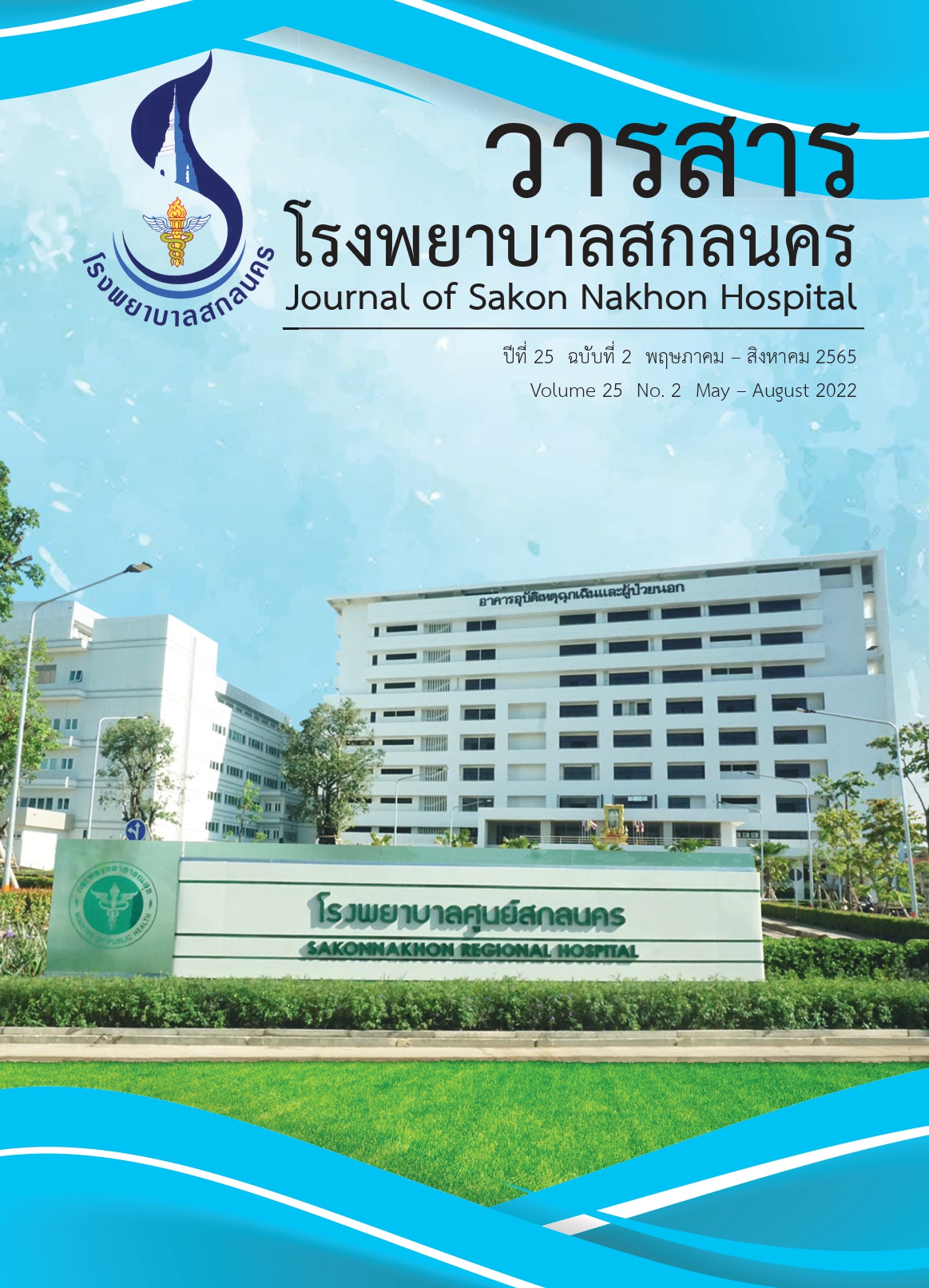การพัฒนาแนวปฏิบัติการพยาบาลในการดูแลผู้ป่วยวิกฤตฉุกเฉินที่มารับบริการ ที่ห้องอุบัติเหตุและฉุกเฉิน ในสถานการณ์ระบาดของโรคโควิด-19 โรงพยาบาลกุมภวาปี
คำสำคัญ:
การพัฒนา, แนวปฏิบัติการพยาบาล, ผู้ป่วยวิกฤตฉุกเฉิน, สถานการณ์ COVID–19บทคัดย่อ
การวิจัยและพัฒนานี้มีวัตถุประสงค์เพื่อพัฒนาและศึกษาผลของแนวปฏิบัติการพยาบาลในการดูแลผู้ป่วยวิกฤตฉุกเฉินมารับบริการที่ห้องอุบัติเหตุและฉุกเฉิน โรงพยาบาลกุมภวาปี ในสถานการณ์ระบาดของโรคโควิด–19 ระหว่างเดือนธันวาคม 2564 – มีนาคม 2565 กลุ่มตัวอย่างได้แก่ พยาบาลวิชาชีพ และเจ้าพนักงานเวชกิจฉุกเฉิน จำนวน 24 คน ปฏิบัติงานที่ห้องอุบัติเหตุและฉุกเฉิน และผู้ป่วยจำนวน 248 ราย โดยเก็บข้อมูลทุติยภูมิจากเวชระเบียนอิเล็กทรอนิกส์ คัดเลือกโดยการสุ่มอย่างเป็นระบบ เครื่องมือที่ใช้ ได้แก่ แนวปฏิบัติการพยาบาลในผู้ป่วยวิกฤตฉุกเฉินแบบสอบถามบุคลากร และแบบบันทึกผลลัพธ์ในผู้ป่วยวิกฤตฉุกเฉิน วิเคราะห์ข้อมูลโดยใช้สถิติ ร้อยละ ค่าเฉลี่ย ส่วนเบี่ยงเบนมาตรฐาน one samples t–test Wilcoxon match–paired test และ binary logistic regression ด้วย ค่า adjusted odds ratios (ORadj) กำหนดระดับนัยสำคัญที่ 0.05
ผลการวิจัยพบว่า ทักษะการพยาบาลในการดูแลผู้ป่วยวิกฤตฉุกเฉินในสถานการณ์ระบาดของโรคโควิด–19เพิ่มขึ้นอย่างมีนัยสำคัญทางสถิติ (p < 0.001) ได้แก่ ค่าเฉลี่ยคะแนนความรู้ (จาก 14.53 เป็น 19.33, S.D. = 1.11) พฤติกรรมการพยาบาลดีขึ้นมากที่สุดด้านสถานที่ Resuscitation (จาก 1.56 เป็น 4.76, S.D. = 0.45) รองลงมา คือการทำความสะอาดอุปกรณ์และห้องความดันลบ (จาก 1.88 เป็น 4.55, S.D. = 0.32) และการเตรียมบุคลากร (จาก 1.79 เป็น 4.45, S.D. = 1.02) ตามลำดับ ผลการสังเกตการปฏิบัติตามแนวปฏิบัติการพยาบาล พบว่า ปฏิบัติถูกต้องร้อยละ 91.2 มีความพึงพอใจการนำแนวปฏิบัติการพยาบาลไปใช้ในระดับมากที่สุดคือ สามารถนำไปปฏิบัติได้จริง (= 4.67, S.D. = 0.49) นำไปใช้ร่วมกับสหสาขาวิชาชีพได้ (
= 4.67, S.D. = 0.62) และช่วยตัดสินใจ เลือกการปฏิบัติได้ง่ายขึ้น (
= 4.60, S.D. = 0.51) ผลลัพธ์ด้านผู้ป่วยพบว่า หลังการใช้แนวปฏิบัติการพยาบาล ผู้ป่วยวิกฤตฉุกเฉิน ปัจจัยที่มีผลต่อ Return of spontaneous circulation (ROSC) in 30 minutes อย่างมีนัย สำคัญทางสถิติ (p < 0.05) ได้แก่ ใส่ท่อทางเดินหายใจใน 10 นาที (ORadj =3.049) อัตราการเต้นของชีพจร (ORadj = 0.318) ค่าความอิ่มตัวของออกซิเจนในเลือด (ORadj = 0.309) ความดันโลหิตซิสโตลิก (ORadj = 0.134) และอุณหภูมิกาย (ORadj = 0.116)
References
พัชรินทร์บุญยก. โควิดสายพันธ์โอไมครอน. ข่าวสาร สคร.11 นครศรีธรรมราช กรมควบคุมโรค [อินเตอร์เนต]. 2564–2565 [เข้าถึงเมื่อ 2 มกราคม 2565]; 21(1):1–8. เข้าถึงได้จาก: https://ddc.moph.go.th/uploads/publish/1223120220128060344.pdf
Christ M, Goransson F, Winter D, Bingisser R, Platz E. Modern triage in the emergency department. Dtsch Arztebl Int 2010;107(50):892–8.
Schreyer KE, Portal DA, King L, Blome A, DeAngelis M, Stauffer K, et al. EMERGENCY DEPARTMENT MANAGEMENT OF THE COVID–19PANDEMIC. Administration of Emergency Medicine. The Journal of Emergency Medicine 2020;59(6):946–951.
โรงพยาบาลกุมภวาปี. ข้อมูลจากสถิติผู้รับบริการห้องอุบัติเหตุฉุกเฉินของโรงพยาบาลกุมภวาปี. อุดรธานี: โรงพยาบาลกุมภวาปี; 2564.
อรุณ จิรวัฒน์กุล. การคำนวณขนาดตัวอย่างและการวิเคราะห์ในการวิจัยกึ่งทดลองทางด้านพฤติกรรมศาสตร์. ว. วิชาการสาธารณสุข 2548;14(5):739–740.
Titler MG, Kleiber C, Steelman VJ, Rakel BA, Budreau G, Everett LQ, et al. The Iowa Model of Evidence–Based Practice to Promote Quality Care. Crit Care Nurs Clin North Am 2001;13(4): 497–509.
อัจฉรา คำมะทิตย์. หลักฐานเชิงประจักษ์ทางการพยาบาล: ค้นหา วิเคราะห์และนำไปใช้อย่างไร วิทยาลัยพยาบาลบรมราชชนนีอุดรธานี. ว. เครือข่ายวิทยาลัยพยาบาลและการสาธารณสุขภาคใต้ 2564;8(2):315–328.
ยุคลธรจิตรเกื้อกูล, อิทธิชัย ชัยแสงแก้ว,วรางคณา พูลเขียว, รัตนาภรณ์กลมคีรี. ผลของการจัดกระบวนการช่วยฟื้นคืนชีพผู้ป่วยหัวใจหยุดเต้นในห้องอุบัติเหตุฉุกเฉินต่อการกลับมาของสัญญาณชีพและการรอดชีวิต. ว. สภาการพยาบาล 2561;33(4):64–74.
กัลยา วานิชย์บัญชา. สถิติสำหรับงานวิจัย. ภาควิชาสถิติคณะพานิชยศาสตร์และการบัญชีจุฬาลงกรณ์ มหาวิทยาลัย. พิมพ์ครั้งที่2. กรุงเทพฯ: จุฬาลงกรณ์มหาวิทยาลัย; 2549.
McManus NM, Offman R, Oetman JD. Emergency Department Management of COVID–19: An Evidence–Based Approach. West J Emerg Med 2020;21(6):32–44.
กรมการแพทย์กระทรวงสาธารณสุข. แนวทางการดูแลผู้ป่วยฉุกเฉินในสถานการณ์การระบาดของ COVID–19. [อินเทอร์เน็ต]. 2563 [เข้าถึงเมื่อ 15 เมษายน 2565]. เข้าถึงได้จาก: https://covid19.dms.go.th
NSW quick reference guide. Emergency department assessment and management of COVID–19 in adults when a patient arrives at emergency. NSW Agency for Clinical Innovation 2020:1–6.
Shrestha An, Shrestha Ab, Sonnenberg T, Shrestha R. COVID–19 Emergency Department Protocols: Experience of Protocol Implementation Through in–situ Simulation. Open Access Emergency Medicine 2020;12:293–303.
Stanton E, Maxwell M, Casados S, Sweeney M, Vannice S, Smith J. Developing Nursing Care Guidelines for Patients With COVID–19. JNPD 2022:49–61.
มะลิสา โรจนหิรัณย์. ประสิทธิผลการใช้แนวทางปฏิบัติในการพยาบาลผู้ป่วยบาดเจ็บหลายระบบ หน่วยงานอุบัติเหตุฉุกเฉินโรงพยาบาลอุดรธานี. ว. การแพทย์โรงพยาบาลอุดรธานี2563;28(3):413–425.
Downloads
เผยแพร่แล้ว
How to Cite
ฉบับ
บท
License
บทความที่ตีพิมพ์ถือว่าเป็นลิขสิทธิ์ของวารสารโรงพยาบาลสกลนคร การคัดลอกเพื่อพัฒนาเชิงวิชาการต้องได้รับการอ้างอิงอย่างถูกต้อง





